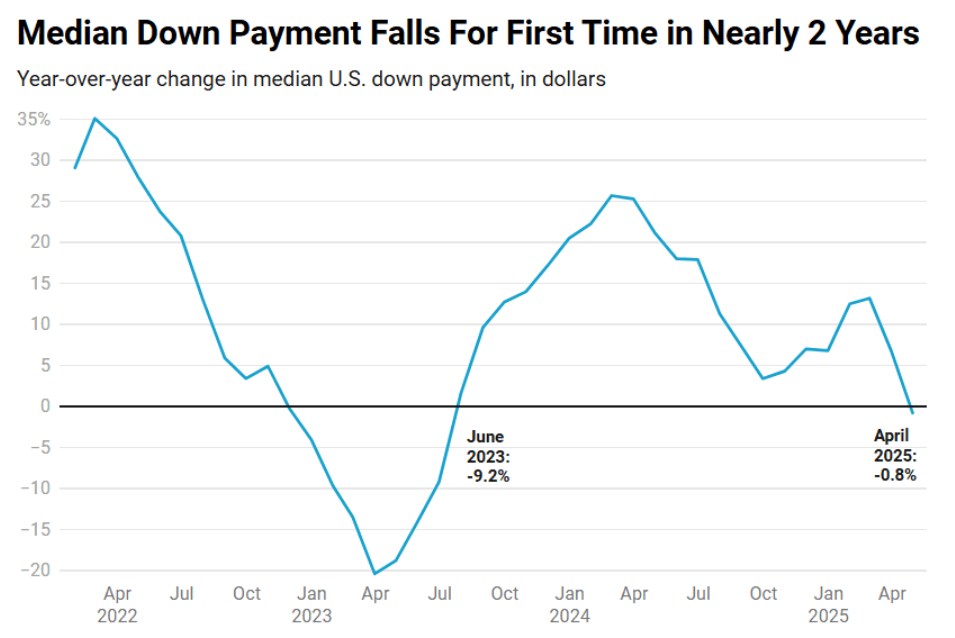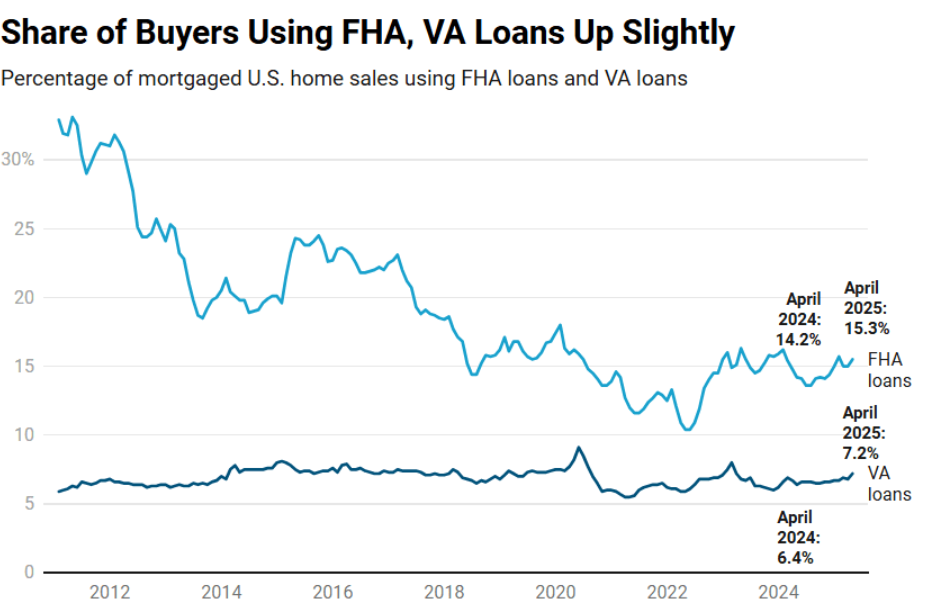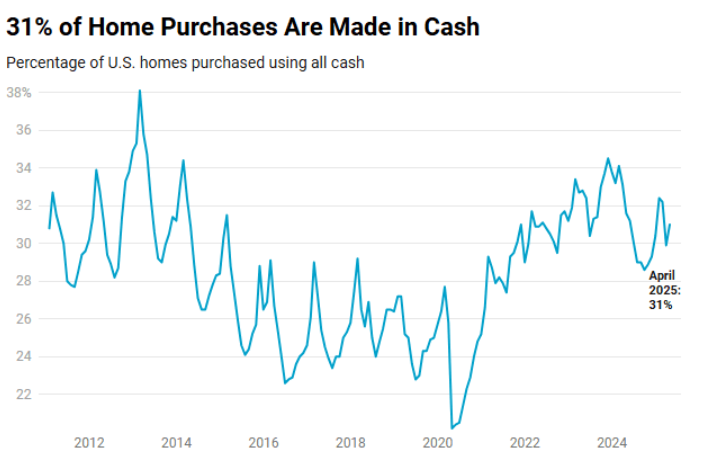Redfin reports that the typical U.S. homebuyer’s down payment is approximately $62,468, down by roughly 1% year-over-year, the first annual decline in nearly two years. For the report, Redfin analyzed county records across 40 of the most populous U.S. metropolitan statistical areas (MSAs).
In percentage terms, the typical U.S. homebuyer puts down 15% of the purchase price, essentially unchanged from 15.1% a year earlier. The median U.S. down payment has been around 15% for the last four years, dipping into the 10% range in early 2023. Before the pandemic, the typical down payment was around 10%.

Down Payments Trending With Home Sale Prices
The last time dollar-amount down payments fell year-over-year was in summer 2023, when home-sale prices were falling. At that time, the decline in home prices was the main reason down payments were falling: when prices are lower, the percentage buyers put down is lower. Now, home prices are rising; they increased 1.4% year-over-year in April. But home-price growth is slowing: for comparison, prices were up roughly 4% at this time in 2024. Slowing price growth is one contributor to lower down payments.
Down payments are falling in dollar terms even though overall home prices are rising slightly because not all homebuyers make a down payment; nearly one-third of buyers pay in all cash. It’s likely that the people buying homes with a mortgage bought cheaper homes, reducing down payments. That also explains why down payments stayed flat in percentage terms but declined in dollar terms.
Mortgaged homebuyers are likely to purchase cheaper homes because of affordability challenges: mortgage rates are near 7%, more than double pandemic-era lows, meaning people are ultra-sensitive to cost. Additionally, there’s an air of economic uncertainty in the U.S.; some house hunters taking out a mortgage may be seeking out cheaper homes, so they have more money in their bank account for security.
“The buyers who are moving forward today are being very careful with their finances because, with housing costs near record highs, they’re typically spending a big portion of their paycheck to buy a home. I’m seeing an uptick in first-time buyers looking for starter homes,” said Fernanda Kriese, a Redfin Premier Agent in Las Vegas. “Combine that with concerns about layoffs and a potential recession, and people are doing things like cross-comparing mortgage origination fees, shopping around for lenders, and looking into down-payment assistance.”
FHA and VA Loans Growing in Popularity
Redfin found that roughly one in every seven (15.3%) mortgaged sales used an FHA loan in April, up from 14.2% a year earlier. The share of mortgaged home sales using a VA loan was 7.2%. That is the highest April level since 2020, and up from 6.4% a year earlier.
More homebuyers are using FHA and VA loans now than a year ago—and more buyers are using VA loans than any spring since 2020—because it is a buyer’s market in much of the country. That means buyers are more likely to get an offer using an FHA or VA loan accepted; in an ultra-competitive market, such as in 2021 and early 2022, the market favors buyers with higher down payments and more ability to prove their financial security. Conventional loans are the most common type of mortgage, by far. Nearly eight in 10 (77.5%) of home loans were conventional in April.

All-Cash Purchases Stabilizing
Just under one in three (30.7%) home sales were all-cash transactions in April, down slightly from 31.6% a year earlier. The share of buyers paying in cash peaked at nearly 35% in 2023 because mortgage rates peaked at nearly 8% during that time. Buyers were inclined to pay in cash—if they could afford it—in an attempt to avoid high monthly interest payments.
Freddie Mac, in its latest Primary Mortgage Market Survey (PMMS) reports that the 30-year fixed-rate mortgage (FRM) averaged 6.84% as of June 12, 2025, down slightly from the previous week when it averaged 6.85%. A year ago, at this time, the 30-year FRM averaged 6.95%, slightly pushing down the share of buyers paying in cash.
“Mortgage rates have moved within a narrow range for the past few months and this week is no different,” said Sam Khater, Freddie Mac’s Chief Economist. “Rate stability, improving inventory and slower house price growth are an encouraging combination as we celebrate National Homeownership Month.”

Key Highlights
- Down payment percentages were highest in three California metros: San Francisco, Anaheim, and San Jose, and in all places, the typical homebuyer put down 25% of the purchase price.
- Down payment percentages were lowest in Virginia Beach, Virginia (1.8%); Detroit, Michigan (5%); and Jacksonville, Florida (5.4%).
- Down payment percentages fell in 11 of the metros Redfin analyzed, with the biggest declines reported in Florida: Orlando, Jacksonville, and Tampa. They rose the most in New York, New York; Baltimore, Maryland; and Riverside, California.
- All-cash home purchases were most prevalent in Cleveland, Ohio and West Palm Beach, Florida, where roughly half of homes were bought in cash. Next came Jacksonville, Florida and Miami, both places where about 40% of homes were bought in cash.
- All-cash home purchases were least common in Oakland, California (18.2%); San Jose, California (18.3%); and Seattle, Washington (18.5%).
- All-cash home purchases increased the most in Cleveland, Ohio; Baltimore, Maryland; and Philadelphia, Pennsylvania.
- All-cash home purchases declined most in Pittsburgh, Pennsylvania; Portland, Oregon; and Sacramento, California.
- FHA loans were most prevalent in Riverside, California, where 26.7% of mortgaged home sales used one, followed by Las Vegas, Nevada (26%) and Tampa, Florida (25.9%).
- FHA loans were least prevalent in California: San Francisco (0.6%), San Jose (1.6%), and Anaheim (4.8%).
- The use of FHA loans declined in just five of the metros Redfin analyzed, with the biggest declines reported in Providence, Rhode Island; Newark, New Jersey; and Milwaukee, Wisconsin.
- The use of FHA loans increased the most in Columbus, Ohio; Tampa, Florida; and Las Vegas, Nevada.
- VA loans were most prevalent in Virginia Beach, Virginia (41.7%); Jacksonville, Florida (18.3%); and Washington, D.C. (16.5%). All of these metros all have a large military presence.
- VA loans were least prevalent in San Francisco, San Jose, and New York, where VA loans made up just 1% or less of mortgaged sales.
- The use of VA loans increased most in Virginia Beach, Virginia; Denver, Colorado; and Jacksonville, Florida.
Click here for more on Redfin’s analysis of U.S. down payment trends.





